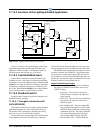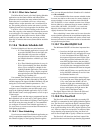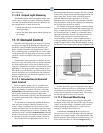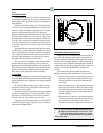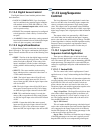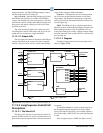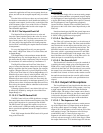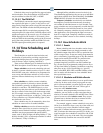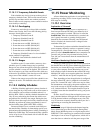
11-40 • E2 RX/BX/CX I&O Manual 026-1614 Rev 4 5-JAN-2013
11.12.4 Digital Sensor Control
The Digital Sensor Control module performs three
basic functions:
• LOGICAL COMBINATION: Up to four inputs
may be combined using standard logical combina
-
tion methods (such as AND, OR, XOR, etc.) The
result is the command output value, which can be
used to operate a relay.
• BYPASS: The command output may be configured
to be bypassed to a fixed value by a switch or but
-
ton press.
• ALARMING: Alarms and notices can be generated
based on the command value of all the digital inputs
of the cell, plus occupancy, and schedules.
11.12.5 Logical Combination
A Digital Sensor Control module has four inputs num-
bered 1 through 4. The logical combination of the Digital
Sensor Control modules follows one of the following strat
-
egies:
• FIRST - The first of the four digital inputs received
will be used as the logical input value. This combi
-
nation first looks at input #1. If the value of this
input is undefined, it looks for other valid inputs,
starting with #2 and descending in numerical order
to #4.
• SELECT - The sensor module reads an analog
input, which provides a numerical value from 1 to
4. This number determines
• AND - The logical input value will be ON only
when all sensor control inputs are ON. If one or
more of them are OFF, then the logical input value
will also be OFF.
• OR - The logical input value will be ON if one or
more sensor control inputs are ON. If all of them
are OFF, the logical input value will also be OFF.
• XOR - This combination strategy is exactly the
same as OR, except when all sensor control inputs
are ON, the logical input value will be OFF instead
of ON.
• VOTE - If more than half of the sensor control
inputs are ON, the logical input value will be ON.
Otherwise, if 50% or less of the sensor control
inputs are OFF, the logical input value will be OFF.
11.13 Loop/Sequence
Control
The Loop Sequence Control application’s main func-
tion is to read the value of an analog input, compare the
value to a setpoint, and generate a single analog output
value. This output value is represented in three different
forms: a single analog value from 0% to 100%, up to eight
digital stage outputs, and a digital pulse width modulation
output.
The output value(s) are generated by a PID Control
cell, which takes into account both the input’s instanta
-
neous value and its rate and direction of change. The PID
Control algorithm is similar to the PID algorithm used by
Pressure Control, except the Loop Sequence Control
application is designed to be used in a wider array of
applications.
11.13.1 Layout of the Loop/
Sequence Control Application
There are two different types of cells in the Loop/
Sequence Control Application: control cells and output
cells. The control cells have a part in determining the PID
output percentage. The output cells convert this PID per
-
centage to staged digital and pulse width modulation acti-
vations.
11.13.1.1 Control Cells
The five control cells in the Loop/Sequence Control
application act as “steps” in determining the final PID per
-
centage.
Step 1: Select - The Select cell determines whether the
occupied setpoint or the unoccupied setpoint will be used
by the PID cell. This cell reads in values for both set
-
points, chooses the one to use based on the value of an
Occupancy input, and sends the appropriate setpoint value
to the next cell in line, the Setpt Float cell.
Step 2: Setpt Float - The Setpt Float cell allows alter-
ation of the control setpoint provided by the Select cell
based on comparison of a “float” input to a range of val
-
ues. The floating setpoint is then sent to the next cell in
line, the PID Control cell.
Step 3: PID Control
This cell makes the PID percentage calculation based
on the value of the setpoint (received from the Setpt Float
cell) compared to the control input, which is fed directly
into the PID Control cell. The resulting percentage is sent
to the next cell in line, the Filter cell.
Step 4: Filter - The Filter cell limits the rate of change
of the PID percentage over time, and is typically used to
keep the PID cell from over-compensating when inputs



